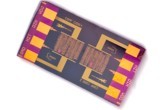Bidirectional communication for thin-film RFIDs
The Holst Centre, Imec and their partners in the EU FP7 project ORICLA have created what is said to be the world’s first RFID (radio frequency identification) circuit made in low-temperature thin-film technology that allows reader-talks-first communication.
The technology behind this prototype can provide RFID tags that are inexpensive and have enough performance to be used as intelligent item-level tags on the packaging of retail consumer goods. Such tags can be used to provide buyers with information on eg, price, characteristics or freshness, or to allow vendors to implement automated billing and inventory management.
Thin-film RFID chips are made on plastic foil, with organic or oxide thin-film semiconductors. Until now, RFID tags with such thin-film chips on plastic were based on a tag-talks-first principle: as soon as the RFID tag gets powered from the RF field of the reader, it transmits its code to the reader. But in retail applications, many tags will try to contact the reader at the same time, requiring an effective anticollision mechanism. Such a scheme is said to have never before been implemented; tag-talks-first RFID anticollision measures have been limited to about maximum four tags and come at the cost of a slow reading time.

“With this technology,” said Paul Heremans, Imec director of large-area electronics and coordinator of ORICLA, “we are, for the first time, able to realise a reader-talks-first low-temperature thin-film transistor (TFT) RFID circuit. When the RFID reader first powers and contacts the tag, it transmits a clock and identification data. The tag then uses this data and clock to determine when to send its code. This mechanism for the first time allows implementing a practical anticollision scheme for thin-film RFID tags.”
For this new RFID tag, a complementary hybrid organic-oxide technology was used, combining a 250°C solution-processed n-type metal-oxide TFT with typical charge carrier mobility of 2 cm2/Vs with a pentacene p-type TFT with mobility of up to 1 cm2/Vs. A high-k Al2O3 dielectric was used, which increases the transistors’ current drive.
The realisation of this technology is supported by the EU FP7 project ORICLA. The project partners are the project coordinator Imec (Belgium), the Holst Centre - TNO (The Netherlands), Evonik Industries AG (Germany) and PolyIC (Germany).
Panasonic offers private 5G network testing in Munich
The simple installation, configuration and maintenance of Panasonic's private 5G network is...
Luxembourg DoD adds satcom ground infrastructure
The Luxembourg Directorate of Defence has procured two new ground stations, following a...
Researchers develop a tuneable terahertz wave filter
A key hurdle to using terahertz signals for routine application is the necessity to tune and...






